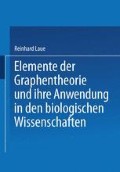Zusammenfassung
Die einfachste Definition einer Menge läßt sich in folgender Weise geben:
-
a ist genau dann ein Element, wenn wenigstens ein x existiert, so daß a Element von x ist.
-
a ist genau dann ein Individuum, wenn a Element ist und wenn für jedes x gilt, daß a stufenkleiner als x ist.
-
a heißt Menge, wenn a kein Individuum ist.
Access this chapter
Tax calculation will be finalised at checkout
Purchases are for personal use only
Preview
Unable to display preview. Download preview PDF.
Literatur zu Abschnitt 3.1
Brinkmann, H.-B., und D. Puppe: Kategorien und Funktoren. Lecture Notes in Mathematics, H. 18. Berlin/Heidelberg/New York 1966.
Görke, L.: Mengen, Relationen, Funktionen. Berlin 1965.
Hasse, M., und L. Michler: Theorie der Kategorien. Mathematische Monographien, Bd. 7. Berlin 1966.
Klaua, D.: Allgemeine Mengenlehre. Ein Fundament der Mathematik. Berlin 1964.
Pontrjagin, L. S.: Grundzüge der kombinatorischen Topologie. Berlin 1956.
van der Waerden, B. L.: Algebra I. 4. Aufl. Berlin/Göttingen/Heidelberg 1955.
Vorlesungsnachschrift über „Kombinatorische Topologie“. Die Vorlesung wurde von Prof. Dr. H. Beckert im Frühjahrssemester 1963 an der Karl-Marx-Universität Leipzig gehalten.
Harary, F., R. Z. Norman und D. Cartwright: Structural Models. An Introduction to the Theory of Directed Graphs. New York/London/Sidney 1965.
Hasse, M., und L. Michler: Theorie der Kategorien. Berlin 1966.
Klaua, D.: Allgemeine Mengenlehre. Ein Fundament der Mathematik. Berlin 1964.
König, D.: Theorie der endlichen und unendlichen Graphen. Leipzig 1936.
Szász, G.: Einführung in die Verbandstheorie (Übers. a. d. Ungar.). Leipzig 1962.
Caylay, A.: Collected mathematical papers, Vol. 3, 242 pp.; Vol. 9, 365pp.; Vol. 13, 26pp. Cambridge 1889–1897.
Harary, F., R.Z. Norman und D. Cartwright: Structural Models. An Introduction to the Theory of Directed Graphs. New York/London/Sidney 1965.
Kirchhoff, G.: Über die Auflösung der Gleichungen, auf welche man bei den Untersuchungen der linearen Verteilung galvanischer Ströme geführt wird. Poggendorfs Ann. Phys. Chem. 72 (1847) S. 497.
König, D.: Theorie der endlichen und unendlichen Graphen. Leipzig 1936.
Poincaré, H.: Complement à l’analysis situs. Rend. Circ. Mat/Palermo 13 (1899) S. 285.
Rescigno, A.: On some topological properties of the Systems of compartments. Bull. Math. Biophysics 26 (1964) S. 31.
Veblen, O.: Analysis Situs. The Cambridge Colloquium 1916, Part II. New York 1922.
Zurmühl, R.: Matrizen und ihre technischen Anwendungen. 3. Aufl. Berlin/Göttingen/Heidelberg 1961.
Theory of Graphs and its Applications. Proceedings of the Symposium held in Smolenice in June 1963. Prag 1964.
Monographien über Graphentheorie
Berge, C.: Théorie des Graphes et ses Applications. Paris 1958.
Busacker, R. G., und T. L. Saaty: Finite Graphs and Networks. An Introduction with Applications. New York/St. Louis/San Francisco/Toronto/London/Sidney 1965.
Harary, F., R. Z. Norman und D. Cartwright: Structural Models. An Introduction to the Theory of Directed Graphs. New York 1965.
Kim, W. H., und R. T. Chien: Topological Analysis and Synthesis of Communication Networks. New York 1962.
Ore, O.: Theory of Graphs. Amer. Math. Soc. Colloq. Pubis., Vol. XXXVIII. Providence 1962.
Ore, O.: Graphs and Their Uses. New York 1963.
Ponstein, J.: Matrices in Graph and Network Theory. Assen 1966.
Seshu, S., und M. B. Reed: Linear Graphs and Electrical Networks. Reading, Mass., 1961.
Wai-Kai Chen: General Topological Analysis of Linear Systems. Coord. Sci. Lab., Univ. of Illinois, Report R-191, 1964 (zitiert nach Ponstein).
Soeben erschienen: Sachs, H.: Einführung in die Theorie der endlichen Graphen, Teil I. Leipzig 1970.
Author information
Authors and Affiliations
Rights and permissions
Copyright information
© 1971 Springer Fachmedien Wiesbaden
About this chapter
Cite this chapter
Laue, R. (1971). Elemente der Graphentheorie. In: Elemente der Graphentheorie und ihre Anwendung in den biologischen Wissenschaften. Vieweg+Teubner Verlag, Wiesbaden. https://doi.org/10.1007/978-3-663-20196-0_3
Download citation
DOI: https://doi.org/10.1007/978-3-663-20196-0_3
Publisher Name: Vieweg+Teubner Verlag, Wiesbaden
Print ISBN: 978-3-663-19858-1
Online ISBN: 978-3-663-20196-0
eBook Packages: Springer Book Archive

